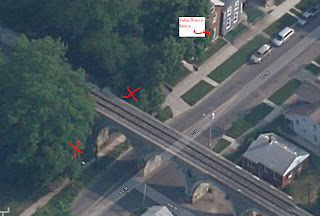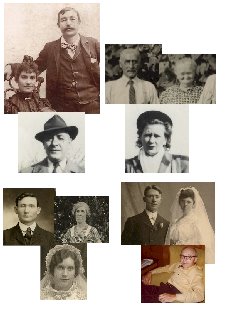The Smith Family in America

Ernst Smith flanked by other baseball team members
James H. Smith: 7/?/1864 to 3/25/1913 (Ernst's parent)
~ (Married abt 1891) ~
Amelia Anna Hatti: 9/25/1864 - 7/31/1950 (Ernst's parent)
Their children:
Amelia: 9/13?/1891 (or 9/16/1892?) in Missouri -to- 1940s in NYC
Anna K: 6/21/1893 in Missouri -to- 3/10/1993 in Swain County, NC
Ella: 5/9/1896 in Missouri -to- 12/271960 in San Diego, CA
Thomas: 12/19/1898 in Ohio - 6/20/73 in Fairfield
Joseph: -/-/1900 in Ohio (died in infancy)
Walter James: 3/28/1901 - 7/17/1901
Ernst: 1/27/1903 in Ohio -to- 12/6/1981 (married on 5/9/1928)
Robert "Bud" George: 9/13/1907 -to- 10/29/1992 in Lawrence, Ohio
Ernst Smith was my grandfather. Ameila Hatti (nicknamed "Gocko") came from Baden, Germany at the age of eighteen (1882). James Smith was born in 1864 in New Jersey, his father an Irish immigrant. James and Amelia met in St. Louis and married in 1891 before moving to Hamilton around 1897. She was a cook at the old YWCA in Hamilton for most of her life. (The present YWCA was built in 1931.) Her obituary is
here.
___________________________________________________________________________________________________________________________

<--Is this James Smith's family?
Familysearch.org returned that result (given inputs of name, birth year, NJ birth state & Irish father). But there are seven or eight strong possibilities in the 1880 census - my best guess
is actually this one although it could be any of
these. The 1870 census presents only three likely
suspects. One slim reed shows the difficulty of figuring out who James' family was:
In the 1870 census there's a single mom named Ellen living in Ewing (county Mercer) in New Jersey. She's raising a 5-yr old named James and a 3-yr old named Thomas. Both were born in New Jersey, with their father born in Ireland.
In the 1880 census, there's a Thomas and James Smith, ages 13 and 15 respectively. Thomas reports his father and mother as Irish and that he'd been born in NJ. James doesn't, putting "Canada" as his birthplace as well as his parents, perhaps as a joke? Because it seems surprising that two young kids named Smith would be living together in Mercer county, each of them with the correct age as in the 1870 census and yet not be
that Thomas & James.
_______________________________________________________________________________
In the 1890 St. Louis City Directory, a James H. Smith was listed as a laborer boarding at 8039 N. Broadway - in the Baden area of North St. Louis.
Searching for the 1891 birth of Amelia Smith, I looked in the Missouri birth records for any girl named "Smith" in September of 1891 (I believe that was her given birth month/year on the '00 census) and came up with one born on 9/13/1891 at
St. Ann's Asylum in North St. Louis, a place for indigent mothers to have their children. No father listed, mother is listed with the same name as the child - the name is "Nellie". Unfortunately "Nellie" doesn't seem to be a 19th century nickname for Amelia. (Common nicknames for Amelia are: "Millie" and "Mellie". One letter off!) Plus St. Ann's was typically a place for unwed mothers, but if Gocko was an unwed mother than the baby's name wouldn't be "Smith". According to a 1901 book,
"The Maternity Hospital is intended for young women whose previous character has been good and whose reception will save the honor of the family. It is also intended for married women, who can receive in this hospital professional attention not possible in their own homes. Poor and homeless widows over sixty years of age are received and cared for in the widows' department."
In 1893, the birth of their child Anna puts them at 2836 DeKalb St, farther south in St. Louis.
In 1896, seventeen years before the devasting 1913 flood, a tornado
struck St. Louis:
"During the same fateful half hour or less thousands of families were rendered homeless and property was destroyed to the extent of fifty millions, or nearly so. It was the most disastrous storm of modern times, and the destruction it worked was far more appalling than that of the Charleston earthquake, generally quoted as the most terrible disaster of the generation. Block after block of residence property for miles in succession was blown to the ground. Houses were demolished down to the foundations; others were left with but fragments of wall, or with fractions of the floor of the first story remaining."
According to the Missouri birth records, their daughter Ella or "Mary Ella Lenore Smith", was born 5/9/1896 at 2220 N. Broadway. In 1896, this address was a bakery run by Bruno Domschke & his wife Augusta, German natives who'd immigrated in 1883, around the same time as Amelia.
 St. Louis locales
St. Louis locales
 1893 location on 1897 map
1893 location on 1897 map
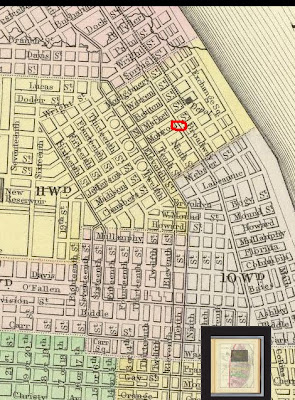 1887 Map of St. Louis; where Ella was born in 1896 circled in red
1887 Map of St. Louis; where Ella was born in 1896 circled in red
If that was their residence, it would place them on the north side of St. Louis which would be very important since the tornado struck mostly the
south & center of St. Louis: "The storm is reported to have struck St. Louis near the corner of Fourteenth and Olive streets and did not do much damage in North St. Louis, confining its work to South and Middle St. Louis and then jumping across to East St. Louis."
The really odd thing in another account written two weeks after the tornado, there was a "James H. Smith" listed among the 80 names of those still missing. But the age given was 25 and our James H. Smith would've been 30 (from
The great cyclone at St. Louis and East St. Louis, May 27, 1896 By Julian Curzon.)
James and Gocko left St. Louis at some point within the next two and a half years since son Thomas was born in Dec. 1898.
<><> </> </>
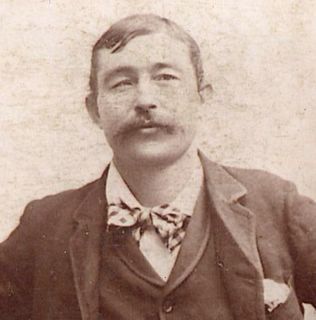
James Smith, 1895 | James Smith apparently died in the Flood of 1913. He lived with Gocko and the kids near the Great Miami River in Hamilton, in the First ward.
They lived in at least three different residences between the years 1900-1913 and the 1913 Hamilton City directory (printed 1912) shows them living in rear 22 South B. Street. He was the only one at home at the time of the flood.
He might've died the morning of Tuesday, March 25th. By ten a.m. the entire Third and Fifth wards of Hamilton were inundated. 200-300 Hamiltonians died in the flood, but the Sixth ward (Lindenwald) was untouched, and East Hamilton also escaped the main ravages of the flood. Over 500 homes were washed away and 10,000 were homeless, including my grandfather Ernst. On this list of Hamilton dead, there is: "James Smith, buried Millville Cemetery". |
Our James Smith?
In the September 1898 edition of the Butler County Democrat, a James Smith fell from a horse requiring a doctor to mend his sprained leg. That same doctor was employed a year later in this 8/17/1899 edition of the Butler County Democrat (the 2 children might be Amelia, 8, and Anna, 6). South B Street was the Smith address around 1912:
"To take the pledge" would be to promise to practice temperance with respect to alcohol.
Where he fell; either to the right or left of the viaduct.
___________________________________________
James' wife, Amelia "Gocko" Smith...
...worked at the YWCA on Third St. - at left is a


picture of the damage in March of 1913 to the rear of the YWCA.
___________________________________________________________________________________________________________________________
From Mark:
"James and Gocko lived right on the river. Gocko worked at the YW but was evacuated. The kids were at school. Bud (my uncle) and Dad at a school on one side of the river and Tom at a school on the other side Gocko hooked up with Tom while Dad and Bud were taken in by a family in Trenton. They lived with this family for about 3 months. No one was home with James. Their house was washed away. There are only 3 houses left on A street. James was out of work in 1913."


From Joan Puma (Dad's sister):
"James wasn't working because he was unemployed at the time (at least I think this is true because in the 1910 census he was unemployed. He may have gotten a job, but he was a blacksmith, so I'm not sure they were in great demand at that time. Anyway, supposedly he drank heavily and that is why Gocko had to work for the YMCA .) The house was 2 stories and they lived at 22 A Street. By the way, they did not own the house. It was rented, according to the census. We may have relatives in Missouri anyway. Gocko came to America with her sister. I think she married someone called Steinhaus or Steinhauser. Seems that what she told us, but I'm not sure.
I went to a luncheon and the guest speaker was Jim Blount. He spoke on the 1913 flood. I asked him where the unclaimed bodies were buried and he told me that they had been buried at #34 in Greenwood Cemetery. He said they kept a record of the bodies: height, color of eyes, hair, etc. and there were people who came later, after the burial, to claim bodies. If he were buried before anyone claimed him, there might not be a death certificate. And then again, he might not have been claimed. Who knows?
Note that from 1917 Amelia Smith was not listed in the city directory. Also note that 1921-24 Gocko is listed as widow of James Smith....but in 1915 she is listed as Mrs. Amelia Smith. I wonder! Could he have left around 1912 and then she got word that he died around 1920? Therefore, she then listed herself as widow for the city directory. Just speculation!"
___________________________________________________________________________________________________________________________
Economic Straits Between 1900 and 1910
The rise of the "horseless carriage" appears to have single-handedly devastated the family's finances. In an 1896 photograph in St. Louis the family appears prosperous, with unlined faces and fancy clothes. In a photo taken between 1911 and 1914, Gocko appears to have aged greatly but it seems less James's fault than his choice of profession.
In 1900, he was listed on the census as a blacksmith and had no months of unemployment. By 1910 he was an out-of-work laborer and had worked only 25 weeks during the previous year of 1909.
Even before 1909 things were tough. From a Jim Blount column:
"In June 1907 a strike closed the local horse shoeing establishments. Requests for a pay raise and a half-day reduction in the six-day work week prompted the short-lived 1907 strike by journeymen in Hamilton shops. 'We now pay the men $18 and $21 apiece for 53 hours work a week,' a shop boss told a reporter as the strike began. 'There isn't a blacksmith in town who has made any money for the last six months,' he explained. 'In that time, horse shoes have gone up $1.05 and nails and everything else has advanced. 'The Standard Oil Company controls the trade,' the owner lamented...After a one-day stalemate, owners and journeymen horse shoers agreed to a 50 cents per day pay increase with no change in the work schedule. Under the new scale, floormen earned $3 a day instead of $2.50, and fireman were paid $3.50 daily instead of $3."
The end was near for the blacksmithing profession. (
Here is a 1904 guide to smithing.) Blount writes,
"In 1900, only 4,192 cars were built in the U. S., but the number increased dramatically during the decade...In May 1911 -- with the demand for horse-drawn vehicles in rapid decline -- Columbia entered receivership. The plant closed by the end of the year.
Horses were the key to Hamilton's economy in 1900, a year when only 13,824 automobiles were registered in the entire United States...There were 16 blacksmith or horse shoe shops and 12 livery stables within the city in 1900. The same source listed 144 males who reported their occupation as either blacksmith or horse shoer. Most were members of Local 75 of the Horse Shoers Union, which met the second and fourth Wednesdays of each month in a building at the southeast corner of South Second and Court streets (now a bank parking lot).."
The Lane Public Library in Hamilton had the Hamilton city directories for 1911, 1912 & 1913. They normally list the wife on the same line (in parathensis) as the husband, unless she's a widow or unmarried. In 1912 it looks like they are separated out, unless there are two James H. Smith laborers in Hamilton.
1911: James H. Smith (Amelia) Laborer 22 S. B Str
1912: Mrs. James Smith Cook 22. S. B. Str.
James H. Smith (Sarah) Laborer 339 N. B. Str.
1913: James H. Smith (Amelia) Laborer 22 S. B. Str
Odd? And, in 1913, there is no "James H. Smith (Sarah)".
___________________________________________________________________________________________________________________________
Children of James & Amelia
James & Amelia's oldest child,
Amelia or "Millie", left for NYC. She was the same age as Mary Pickford and New York was the epicenter of the early film industry. She had gone to NY to become an actress and model. Joan recalls that there was a "a cigar tin with Millie's (Dad'd sister) on it. I think the cigar (Muriel?) tin is the only modeling job she had. It was the one for cigars with a rose in her mouth. I don't know too much about Millie except when she died (in the 1940's) she was buried in Potter's Field in New York [i.e.
Hart Island]. We didn't have enough money to have her body shipped back to Gocko."
Millie would've been about 15 when the first Nickelodeon, or first movie theatre, came to Hamilton. The first one opened in Pittsburgh and within ten years the boom was over and more expensive theatres were opened:
Nickelodeons sprang up all over the country. At first, they were mainly patronized by the working class. There was still a lot of resistance from the gentility...In a 1907 look at the nickelodeon boom in the Saturday Evening Post, Joseph Medill Patterson wrote: "Already a good many people are disturbed by what they do know of the thing. Those who are 'interested in the poor' are wondering whether the five-cent theatre is a good influence, and asking themselves gravely whether it should be encouraged or checked (with the help of the police). Is the theatre a 'good' or a 'bad' influence? The adjectives don't fit the case. Neither do they fit the case of the nickelodeon, which is merely the theatre democratized."
Amelia Jr's address in 1941 was in the Lower East Side, the poorest section of Manhattan and a melting pot of ethnicities. Built in 1920, in 1933 there was a Sicilian (Giuseppi Leonti) who murdered his daughter in that tenement building and was later given the death penalty.
A 1946 Manhattan city directory has a Mildred Arnold at 315 W. 14th in Chelsea; don't know if it's her. Chelsea had a lot of tenements too, but was generally a bit better off than Broome Street. (
http://www.1940snewyork.com/)
____
17-yr old
Anna Kathleen wasn't listed as living at home in 1910 census. At 20, around 1913, she got married. Joan says: "If I am not mistaken, Aunt Anna lived with Kate [NB: actually Nancy] Hixon and later married her son, Frank." Frank & his parents were from Kentucky. They were on the 1930 census as living in Hamilton, Oh (224 Cleveland Ave) with Frank listed as a fireman at a paper mill. It's said that Frank was a Baptist but agreed to convert to Catholicism; they went to the priest's house to talk about getting married and "the housekeeper said the priest wasn't there. Frank said he had seen the priest thru the window and told the housekeeper that but she insisted that he was seeing things. He concluded that he didn't want to participate with people who lied and apparently Grandmother wanted to marry him enough that she was willing to become a protestant. That's how his line became Baptist." It seems one of the grandchildren of aunt Anna, a Christian missionary son of Anna's son William, escaped a
murderous rampage in Yemen.
By the time of WWII, they were still in Butler County but then they moved on. Anna lived in Florida for awhile but moved to be with her son, Bobby Hixon in Ashland, NC (Swain Cnty) in 1993, living to the age of 99. William was another son of hers. Joan writes,
"she had 3 children...Billy, Bobby, and Katie. Anna went to Florida. I can't remember Katie's married name [Storch], but she lived in Florida, also. Bobby was a preacher and also mayor of a city in Florida...he was pretty handsome and full of.... When they moved to No. Carolina, Billy and Bobby went over the mountain in a car and it was pretty serious. It left Bobby with brain damage. I think Billy was OK. There were children involved - at least I know Bobby was married and had kids who lived in No. Carolina. I think they lived near Ashville."
By 1910, 14-yr old
Ella, full name Mary Ella Lenore was placed in a
home for girls in nearby Ft. Thomas, KY. (Convent of the Good Shepherd photos
here and
here.) perhaps due to poverty or to learn vocation skills such as sewing. Found on the 'net:
By the 1800s Good Shepherd was also serving as an orphanage. Accounts say 72 children were being housed there in 1881. The focus of the home shifted to "problem girls" in 1885 with a special wing added onto the complex in 1890. A rectory for a priest was added in 1895 and a new convent building was started in June 1903 and dedicated on May 15, 1905. The complex expanded further in 1908 with a school building to teach vocational skills, such as sewing and fine embroidery, for which the school and convent would alter become well known.
Joan says of Ella, "I remember her as being very pretty and was married to a rich guy named William Everett Stout (I think) who owned an airplane at Hogans Airport. He was in an airplane crash, but he survived. Still have the paper on it, I think. She is the one who owned the movie camera back in 1935. She also was a beautician because I can remember her giving me a perm at a beauty salon. They moved to Staurt, Florida and then on to California." It was said she died of breast cancer. E. Storch writes of her husband,
"His full name was William Everett Stout or Everett William Stout. He was Ella's (Anna Kathleen Smith Hixon's sister) husband. Some called him Bill and some called him Everett. In 1955 and 1956, Ella and Bill/Everett lived in Pasadena, CA. I don't know when they moved there, but I'm pretty sure it was the early '50s. My grandmother and I spent three weeks with them in 1948 when they lived in Stuart, FL. I don't recall ever knowing what Everett did for a living. I know they owned a beauty shop in Hamilton during the War. He owned two airplanes before his accident. They lived in a beautiful home in Fairfield township with at least a couple acres of land. They moved to Florida, I believe, after the War. They ran a bed and breakfast on the St. Lucie River in Stuart. He was a fishing guide (not deep sea but on the river). It seemed to me this was a hobby for them. They never seemed to be in need of money and I don't recall him working. They were the rich relatives. Both of them were always very good to me. They took me around the LA area when I went to the '56 Rose Bowl Game."
A line from the Butler County Democrat in 1914 said, "Mrs. James Smith visited Mrs. John Stout last week." Perhaps Mrs. John Stout was the mother of William Everett, and perhaps they were consulting about Ella's marriage.
Mary Stout died in 1960 in San Diego, CA of breast cancer.
Thomas H's wife Marie Karcher (married a Karcher in mid '30s) was just 15, he 22, when they married(?) in 1921. By 1930 they had Thomas Jr. (b. 1922) and Raymond (b. 1923). There were other siblings nicknamed "Red (Raymond) and Googe (not Thomas, but who?)" (Said one family member: "Red may have been in trouble and I don't think was at Tom's funeral. I think Red was as mysterious as James. Ern talked about as much about Red as he did James - very little.")
According to Thomas H's WWI registration card (signed a month before the end of the war), he was of medium build and height and had brown eyes and hair and lived with Gocko at 128 N. 3rd. He was working as a farm hand for James Cole at that time. Thomas died in '73 and his then wife Mattie died just 4 days after he did, as if of a broken heart.
1930 = 8 yr old Thomas living at home with brother Raymond, uncle Robert and father Thomas H.
1934 = Thomas H. & Mattie Jones marry
1940 = 18-year old Thomas living with Homer and Mary Herr, his grandparents.
(Homer Herr's daughters were Sylvia Herr , born in 1906 and Silester or Celeste Herr in 1908 )
6/21/1973 = Thomas Smith Jr. living in Hamilton
6/1974 = daughter of Thomas Smith married in Hamilton (Jan Marie Smith (Brown))
6/27/75 = Raymond's death
8/25/75 = late Thomas Smith mentioned in article; may be a different one.
With Raymond might have been some mental issues after the war (he served in both WWII and Korea).
Thomas W. Smith of Dayton born Jan 1921 looks like a different Thomas?
Ernst used to work at a bowling alley setting up pins. Married on 5/9/1928. (Pictures and much more info about him later.)
In 1920, at the age of 12,
Robert George (or "Bud") was living with and working for a farmer named Nimrod Paxson in Somerville (Preble county), south of Eaton and just north of Butler County. He received only a grammar school education. In 1930, 22-yr old Robert was single and living with married brother Thomas's family. By the time World War II rolled around, he was working as a bartender, divorced with no dependents. He married Irene sometime before 1940. He served honorably in the army during WWII from 2-17-42 to 10-24-45. He out-lived Irene by over a decade (she lived 1904-12/9/1979). By November of 1971, they were living in Lawrence County, Ohio, near the city of Ironton. He died in 1992. He had cancer.
___________________________________________________________________________________________________________________________

James & Amelia & presumably Amelia & Anna,
taken in MO in late 1894/early 1895.
(click photo to enlarge) 
This picture was interesting enough to prompt research about a topic I know nothing about: fashion. His suit was a "narrow cutaway sack coat", very popular in the 1890s with the advent of catalog shopping. He also has gold watch chain leading to a fob.
Her hair bobbed in late 1880s style, high collar set off by bar pin, basque bodice with ornate buttons. Sleeves were 'bishop sleeves' although by the mid 1890s much fuller sleevers were becoming popular. High straight collars became the fashion. "To permit one's neck to show in daytime is bad form" (Ladies' Home Journal Aug. 1890). "All of us who are wise, possess a black gown." (
Godey's 1896) Sleeves inflated as the decade went on until in 1896 the sleeve extended almost horizontally from the shoulder. Then it deflated again.
___________________________________________________________________________________________________________________________
From Ernst Smith's 1921-1922 Hamilton High Yearbooks:









1938 Smith Family Photos (Click to enlarge)
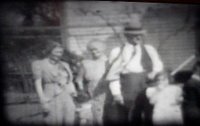
Ruth Smith at left, with her parents between grandchildren
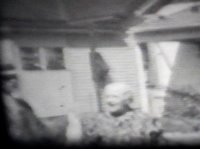
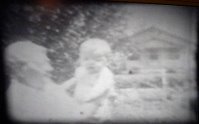
Gocko (with Mark at right)
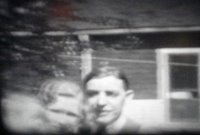
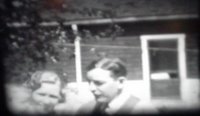
Ernst & Ruth in their early to mid-30s
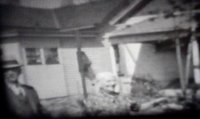
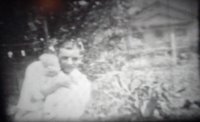
Gocko at left; Mark & Ernst on right
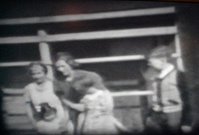
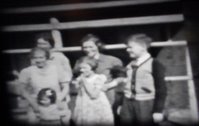
Ruth in center
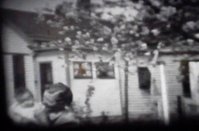
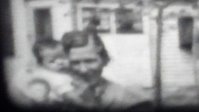
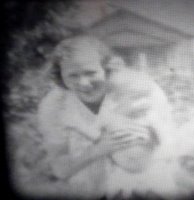 Mark & Ruth
Mark & Ruth
___________________________________________________________________________________________________________________________
The absence of family history creates a want for it; nature abhors a vacuum. Smith is a name without a lot of meaning. I imagine James Smith, my great-grandfather, could give it the meaning. In 1913 there was a flood. Did he perish in it? Sometimes I imagine - what if he wrote us a letter?...
I made passage to the confluence of the Missouri & Mississippi rivers at St.Louis sometime in 1885. I had heard the land was cheap and I'd read Westerns and I knew St. Louis was the gateway to the west. I met this gal Amelia in 1890 at market. She looked pretty and even better she put up with my boozin'. I guess it was that foreign accent that did it. She came over on the boat from old Deutschland in '83 when she was 18. In America the church folk hated the Germans, said they were pompous and high-falutin'. I was always pretty much a rebel, stirrin' up the pot, so I rebelled against me fellow Irish. I 'spose Amelia wasn't waiting for Prince Charmin', she was 27, but she had a tolerant streak and that's just what I needed - a tolerant wife. We had a daughter, named for her mother. I let Amelia name them all Germanic names, except for Thomas - I insisted one be named somehing Irish-sounding.
We settled down to our marital bliss, had Anna less than two yrs later, then Ella three years after that. Moved to Ohio, around 1897. Heard the jobs were there. Needed a job. Knew somebody there too, that might've been part of it. Hamilton, Ohio was the ticket. Kind of spur of the moment you know, didn't think I'd have a hundred ancestors livin' there within a hundred years you know! Thomas was born 'round Christmas in 1898, and then we had Joseph in '01 but soon lost him. Little Ernie came in 1903. His sister grew up and had a case of the New-Yorkitis, left for fame & fortune. Wanted to be an actress but died a pauper in the city. Ernst married another German, like his father, and she was a pious one and her family had were well-off, not like us, with our house renting.
We were in Ohio for sixteen years before the Great Flood of 1913. I'd moved from one big river to a smaller river but you wouldn't know it in 1913. From the Mississippi to the Miami, but there wasn't no levy then. The river rose and rose till it spilled its banks and in one fell swoop, like a hatchet, came down on us, wreaking destruction and desolation and killing over 100 Hamiltonians. Including me. From 1891 to 1913 I was a husband and father. That's 22 years of marriage, and that ain't chicken feed. If I was lookin' to find another dame, you think I'd need a flood as an excuse? You think I wouldn't have taken off before then, probably during a bender? The argument against my death in the flood was that they never found my body or even recorded my death in the newspaper. But it was chaos then. Besides, maybe every family needs a bit of mystery.
___________________________________________________________________________________________________________________________

 |
Grandfather Ernst, nicknamed "Gunner" after a fighter named Gunboat Smith (perhaps Grandpa was a good fighter?), didn't like guns. Didn't want anything to do with them. After a tragic Easter in which one Hamilton family member shot and killed all eleven family members, Ernst always wondered if there was a "Rupert" among them. "Probably an in-law", he humorously opined.
He had a brother Joseph J., born 7/17/1901 in East Hamilton, and at least two other brothers that we know of (Bud & Thomas) and three sisters. Ernst attended Hamilton High School and won many swimming and diving trophies which he says were "lost in
the flood" despite the flood occuring when he was only ten.
Married on 5/9/1928 at around the age of 25.
Almost twenty years a widower, "Papa" was the universally beloved patriarch of the Smith family. He was recently honored at a memorial day at a local horse race track. |
 ___________________________________________________________________________________________________________________________
___________________________________________________________________________________________________________________________
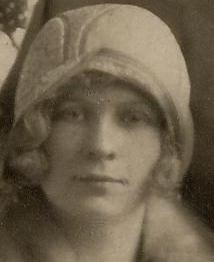
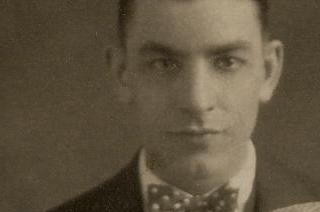 Grandma Ruth & "Papa" Ernst (mid-to-late 1920s)
___________________________________________________________________________________________________________________________
Where We Grew Up
Grandma Ruth & "Papa" Ernst (mid-to-late 1920s)
___________________________________________________________________________________________________________________________
Where We Grew Up

The red dot is where we would
eventually live; click to enlarge
Mark's children grew up on Ponderosa Dr. in what is now Farifield, Ohio. In this 1875
map, it looks like either George Rue or George Muskopf farmed the land I later grew tomatoes on as a 12-yr old.
George W. Rue, born in Kentucky in 1829. In 1870 he was a 41-year old farmer, and had 20,000 ($300,000 in today's dollars) worth of real estate and $1500 ($23,000) in personal estate. He retired to Lindenwald a few years later, before the age of 52, passing the farm to his son Isaac. By 1900 the property was not in a Rue's hands.
Possibly George Muskopf owned it, a 28-yr old from Bavaria who immigrated with his family as a child. He farmed it continuously till at least 1910, when in his 60s.
2007 Gunner Smith Memorial
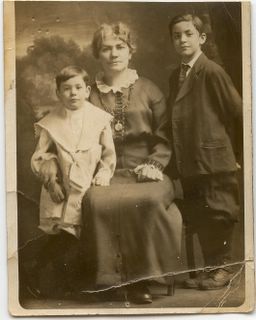

 Joan remembers Gocko teaching them a little prayer in German. In English it's: "I am little. My heart is pure. I don't want anyone in except Jesus alone." In German it rhymes:
Joan remembers Gocko teaching them a little prayer in German. In English it's: "I am little. My heart is pure. I don't want anyone in except Jesus alone." In German it rhymes: Dad remembers Gocko having them kneel before bedtime and reciting the children's prayer "Now I lay me down to sleep".
Dad remembers Gocko having them kneel before bedtime and reciting the children's prayer "Now I lay me down to sleep". 

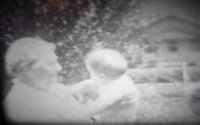

 The Hesse_Darmstadt/Hesse-Kassel areas are near the Rhine river near Wiesbaden, about 100 miles north of Baden-Baden.
The Hesse_Darmstadt/Hesse-Kassel areas are near the Rhine river near Wiesbaden, about 100 miles north of Baden-Baden.






